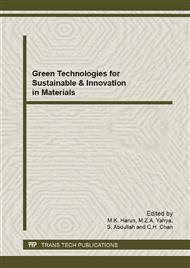p.125
p.130
p.137
p.145
p.157
p.164
p.170
p.180
p.192
Fabrication and Characterisation of Powder Metallurgy Fe-Cr Matrix Composites Reinforced with Al2O3
Abstract:
Abstract. Sintered powder metallurgy Fe based composites with advanced mechanical properties have been proposed as substitutes for more expensive cemented carbide and wrought alloys in many applications, especially as inexpensive wear resistance parts. The aim of this work was to fabricate and characterize a composite made of Fe-Cr as the matrix and Al2O3 particles as reinforcement. The composite was made by powder metallurgy method. The effect of different amount of binder, mixing duration, compaction pressure and sintering temperature has been investigated. Densification, micro hardness, wear resistance and compressive strength were used to characterize the composite. Powder metallurgy parameters that satisfy the composites quality have been optimized and result showed that higher sintering temperatures promote good sintering in the composites which produced better densification, higher reading of micro hardness, better wear resistance and compressive strength.
Info:
Periodical:
Pages:
157-163
Citation:
Online since:
April 2013
Keywords:
Price:
Сopyright:
© 2013 Trans Tech Publications Ltd. All Rights Reserved
Share:
Citation:


